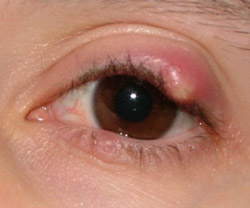Most of the eye allergies are annoying, occasionally severe allergies in eye may threaten eyesight. Most of the allergies of eye have association with other allergic conditions, particularly hay fever (allergic rhinitis) and atopic eczema (dermatitis). Medications and cosmetics may also cause eye allergies. Eye allergy and eye irritations are often confused with each other. Irritants, environmental or manmade, can also cause similar symptoms of eye allergies. The most common form of eye allergy, seasonal allergic conjunctivitis (SAC) is caused by seasonal triggers such as grass and ragweed pollens. Another form of allergy of eyes, perennial allergic conjunctivitis (PAC) is also very common. The allergens in this type of eye allergy are, animal scales, feathers or dust mites. Allergies on the conjunctiva cause red eyes. One of the common causes of red eye from allergies is allergens or environmental irritants. Seasonal allergies can be the reason for itchy eyes. Eye allergies cause itchy eyes, which are overreactions to foreign bodies by the immune system. Another important symptom of allergy, the swollen eye is caused by the retention of fluid by the eye tissues due to allergies. It is important to find out if the agents for swollen eyes are from allergies.
Treatment: Oral antihistamines may be used for itchy eyes. The most common remedies for eye allergies are to get away from the allergens, or antigens, that cause these symptoms. Cold compresses can be used for relief.
Sty (Stye)
A painful red bump formed at the base of an eyelash or inside the eyelid is called a sty or a stye or it can be explained as a swelling on the eyelid. The causes of sty can be a localized infection of the glands or a hair follicle of the eyelid. External styes formed as small red bumps above the eyelid whereas internal styes are infections of the meibomian sebaceous glands lining the inner side of the eyes. A sty in the eye is a consequence of the obstruction of the meibomian glands, which lubricate the eyeball and eventually results in infection. The causes of sty are mainly a bacterium, Staphylococcus aureus, which cause infection. Styes can be formed at any age, in particular in infants. The triggering factors are poor nutrition, inadequate sleep, less hygiene or rubbing of the eyes. At times sty is confused with a chalazion, another eye infection. Sty symptoms include redness, tenderness and pain in the affected area.

Stye treatment: Home remedies for sty include the use of warm compresses. Most of the sty on the eye do not need treatment and it resolve by their own. Sty eye treatment includes incision and drainage and is executed if there is no settlement of sty after 48 hours of warm compress. The ophthalmologist may prescribe oral or intravenous antibiotics as stye remedies in some cases. Stye eye infections that do not respond to any type of therapies are usually surgically removed.










